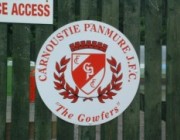What's in a game?

Albion Rovers – called ‘The Wee Rovers’ (the little Rovers). The word ‘wee’ is, of course, the Scots word for little.
Arbroath – called ‘The Reid Lichties’ (the little red lights) which is thought to refer to the red light that was used to guide fishing boats into the harbour of Arbroath.
Ayr United – called ‘The Honest Men’ which is taken from the Robert Burns poem ‘Tam o Shanter’ – ‘Auld Ayr, wham ne’er a town surpasses/ For honest men and bonie lasses’.
Berwick Rangers – called ‘The Borderers’ or ‘The Wee Gers’ (the little Rangers) to distinguish them from Glasgow Rangers.
Carnoustie Panmure – called ‘The Gowfers’ (the golfers). Carnoustie is, of course, well known for its golf courses. In Scots we say ‘gowf’ and not ‘golf’ which is an English pronunciation.
Clyde – called ‘The Bully Wee’ (the good little). This probably derives from the Victorian word ‘bully’, meaning good or first rate and because the club was quite small it was known as the ‘The Bully Wee Clyde’ (the first rate little Clyde).
Falkirk – called ‘The Bairns’ (the children). This nickname is taken from the motto of the burgh of Falkirk which warns: “Better meddle wi the deil than the Bairns o Fawkirk’ (better meddle with the devil than the children of Falkirk). In Scots the name of the town is The Fawkirk (the speckled church).
Forfar Athletic – called ‘The Loons’ (the boys or lads). The Scots word ‘loun/loon’ means particularly ‘boy’ or ‘lad’ but can also mean ‘men’ or ‘people’ in more general senses. It is believed to derive from Dutch and first appears in Scots in the 17th century. Today it is most commonly used in North East Scotland. Forfar is called ‘Farfar’ in Scots and sits on the line between Central and North East Scots speech. As the rhyme states “Bi foo, fit, far an fan, ye can tell a Farfar man.”
Glasgow Rangers – called ‘The Gers’ or ‘The Licht Blues’ (the Light Blues) from the original colour of the jersey. In the last few years the motto of the club ‘Aye Ready’ (always ready) has, for some reason, simply become ‘Ready’, dropping the Scots ‘aye’ altogether. In Scots the city is called ‘Glesca’ or ‘Glescae’.
Partick Thistle – called ‘The Jags’ (the prickles). This derives from the Scots word ‘jag’ or ‘jaggie’ which means ‘prick/pierce’ or ‘prickly’ which is a good description of a thistle. The Scots for thistle is ‘thrissle’.
Peterhead – called ‘The Blue Toon’ (the blue town) which is the nickname for the town. Natives of Peterhead, particularly fishermen, were called ‘blue mogganers’ which derives from the word ‘moggan’, meaning a type of covering worn around the legs. In Scots the town is called ‘Peterheid’.
Queen of the South – called ‘The Doonhamers’ (the downhomers). This is the local name for natives of Dumfries and also refers to ‘doon’ which is one of the Scots words for a goal place (the other more common word for a goal in Scots is a ‘dale’.)
Saint Mirren – called ‘The Buddies’ (the people) which is derived from the Scots ‘body’, meaning ‘person’ and often pronounced to sound like ‘buddie’.